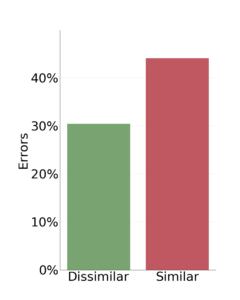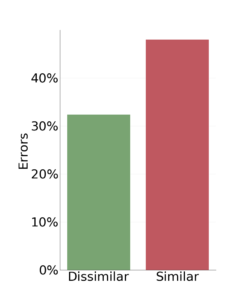A granny summary of an article by Dror Dotan and Sharon Zviran-Ginat
Elementary math in elementary school: The effect of interference on learning the multiplication table
Why is it that math is so displeasing, or even frightening, for children? One set of answers may relate this to social, cultural and emotional reasons. For example, perhaps we think too highly of math as a field that reflects our mental capacity – only if we succeed in math, we are considered as intelligent. It’s also possible that since incorrect answers are very obvious in math exercises, it brings about discouraging feelings. But there are probably more objective, cognitive reasons to this dreading of math. One of them could be the need to memorize quite a few numerical and mathematical facts, such as the multiplication table. Even many adults are overwhelmed when they recall themselves studying it. How come? What’s the deal with the multiplication table, and can it be easily studied?
In order to answer this question, we first need to understand that we usually do not calculate when we multiply. We literally remember the multiplication table by heart, each fact separately. It is of course possible to calculate, or to use other numerical tricks. For example, when we our asked how much is 7×6, we may rely on our existing knowledge that 7×3=21. However, children are required to solve basic multiplication exercises so quickly and precisely, that they must memorize. Looking into the 1-10 multiplication table, and putting aside multiplication facts including 1, 0 and 10 (which rely on a general rule and are not memorized), and facts including 2 (which can be solved by adding, e.g. 6+6), we are still left with 28 multiplication facts to memorize. Now, consider fact that most of these exercises are comprised of 4 words (for instance, 4×8=32 is four × eight = thirty two). That’s a lot to remember by heart! If it still sounds easy to you, take a few seconds and try to memorize the following list:
Seven and five are ninety three
Eight and seven are thirty five
Five and three are twenty nine
Three and nine are fifty eight
Tricky, right? And these are only 4. Try memorizing 28 of those.
What makes this so difficult is that these exercises are extremely similar to each other, since the same numbers appear more than once (as they did in the list above). Many studies have revealed that it is more difficult to memorize items consisting of similar components than dissimilar ones, as these components interfere with each other. This is called proactive interference. Some people have an extremely high sensitivity to proactive interference, which in turn makes it extremely difficult for them to memorize the multiplication table. Often, these individuals will be considered as suffering from mathematical learning disorder – dyscalculia.
On top of that there is the way in which the multiplication table is taught in school. In most cases, it is taught column by column: first the products of 2, then the products of 3, and so on. We use this method for various reasons – for example, it may help understanding how the multiplication table is organized. But an unwelcomed by-product of this method is that in each lesson, we teach a bunch of very, very similar exercises. Speaking of proactive interference…
In the present study, we examined what happens when we use a different method. It’s quite simple, actually: we already understood that difficulty is generated by proactive interference, which is stimulated by teaching similar exercises at the same session. Well, what if we were to teach only dissimilar exercises at the same session? This is precisely what we did. In every session, the children only learned exercises that were dissimilar from each other; similar exercises did not appear in a single lesson. For instance, 9×3=27 and 6×8=48 could be included in one lesson, as they are quite distinct; but 6×8=48 and 8×8=64, which are rather similar, would be separated into two sessions. In a previous research, we demonstrated that this method worked well on a woman with high sensitivity to proactive interference. In the present research, we wanted to see whether the same method would be effective for children without any learning disorders.
The participants were a group of first graders, who have not yet studied the multiplication table. We taught them the multiplication table in two contrasting methods: (i) similar exercises in each session; (ii) dissimilar exercises in each session. For four weeks, each child had two weeks in which she studied similar exercises, and two weeks in which she studied dissimilar exercises. The results were pretty amazing: the children reached much better outcomes during the two weeks with the dissimilar exercises sessions. How much better? When the exercises were similar to each other, children had 1.5 more errors than when they were dissimilar (figure 1).

Figure 1. The percentage of errors was examined at the end of each learning week. When the exercises in a particular week were dissimilar from each other, children had fewer errors (green) than when they were similar to each other (red).
The similarity effect was revealed even when we tested the children a few weeks after the end of the experiment (Figure 2). That is, the low-similarity learning method was effective not only during the learning process, but it also had an impact on long-term memory. This has pedagogically critical implications – it means that proactive interference makes learning not only easier, but also more effective in the long run.

Figure 2. Seven weeks after the end of the experiment, the effect of similarity was still apparent. In this test, children chose the correct answer out of two alternatives (50% = guessing level)
So what’s our conclusion? We’re not saying that the existing method, teaching the multiplication table column by column, is all bad. Learning the multiplication table according to columns certainly has its advantages, for example, it helps students understand the logic behind multiplying, and it also helps them to construct alternative strategies in case they can’t remember one of the multiplication facts. However, maybe after an initial stage of column-by-column learning, the multiplication table should be memorized in a different method, based on grouping together exercises that are dissimilar.
Interested in more details? The full article is here.
